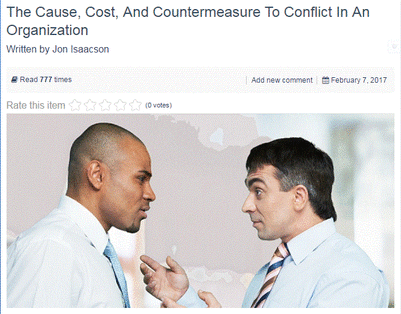 "If we don't battle to the death, they will kill us both" "If we don't battle to the death, they will kill us both" Originally published as The Cause, Cost and Countermeasure to Conflict in an Organization in The Project Management Times By Jon Isaacson If you have dysfunction in your team, the cost may be higher than you want to admit but the cure may also be closer than you realize. Frustration in the workplace, does such a thing exist? In a recent article in Forbes magazine, researchers discussed the primary sources of disgruntlement within organizations. According to the study, most employees noted that they were frustrated by personality differences and incompetence in their co-workers. This is not news to anyone who has worked in an organizational setting, one human plus one human will eventually equal conflict. The potential for conflict, as well as the intensity and duration, are compounded by the number of humans added to the equation. More people, more problems. What is interesting about the Forbes article is that upon further investigation there was an underlying source which contributed to the environment of dysfunction, “In fact, teams having conflict had much higher levels of ambiguity in three categories of work: their team’s goals, roles, and procedures. So, while it is very human to assign personal motive and blame in times of trouble, there isn’t really anything personal about the core of workplace conflict. If you back up and look at the facts, a lack of clarity is what’s truly to blame.” (Wakeman, 2015) The need for clarity is foundational to functionality and trust within an organization. Where there is a lack of clarity, there will be conflict. Office drama is costly, CPP Inc. performed a study in 2008 which discovered that employees in the United States spent 2.8 hours per week dealing with conflict which CPP estimated as costing over $359 billion in paid hours or the equivalent of 385 million working days (Lawler, 2010). Every business understands the need to watch the bottom line, so why are mangers unwilling to recognize the high cost of conflict? Think of it, if every employee in your office could increase engagement and efficiency by 7% by only changing one element, wouldn’t that be something a wise leader would be more intentional about? Recognize the cost of inaction. Managers spend much of their time putting out fires, and yet our discussion to this point has demonstrated that the cure for dysfunction may be closer that you think. By understanding the cost of conflict, we recognize the value of investing in practices that will help our organization to identify and address these hot beds of discordance within our teams. Realize the need to eliminate the blame game. When employees focus on blaming each other, too often managers are happy to allow them to target their ire upon each other rather than dealing with the core of these issues which creates a negatively recurring cycle. As noted by the author in a prior article - how leaders respond to conflicts can either reinforce cultural values that strengthen the team, or they can respond in ways that destroy morale (Isaacson, 2016). Reduce conflict by creating clarity. If the research from Wakeman and her team as outlined in Forbes is accurate, then leaders can make a significant reduction in interpersonal conflict by being more intentional about organizational clarity. As a leader, you can alleviate friction between team members by being more clear about team goals, roles, and procedures as quoted above. If we can sense the frustration in the organization and we can calculate the deep costs, we should be proactive in working towards long-term solutions. Often inaction is caused by an inability to identify the causes or formulate an effective plan, but now that these have been brought to light the only question left is whether we will be intentional about getting into the mix to make the magic happen. There are no shortcuts when working with interpersonal dynamics but progress is attainable through the countermeasures for the conflict we have discussed. References Wakeman, Cy (2015, June 22) The number 1 source of workplace conflict, and how to avoid it. Forbes. Retrieved fromhttp://www.forbes.com/sites/cywakeman/2015/06/22/the-1-source-of-workplace-conflict-and-how-to-avoid-it/#32a27f89126e Lawler, Jennifer (2010, June 21) The real cost of workplace conflict. Entrepreneur. Retrieved fromhttps://www.entrepreneur.com/article/207196 Isaacson, Jon (2016, July 11) Eliminating blame in your organization. Retrieved from http://izvents.weebly.com/words/eliminating-blame-in-your-organization
0 Comments
 If you didn't catch the nuggets of knowledge when the article The Cause, Cost and Countermeasure to Conflict in an Organization was published with the Project Management Times, you know have the opportunity to read it through the Business Analyst Times. Excerpt, "Recognize the cost of inaction. Managers spend much of their time putting out fires, and yet our discussion to this point has demonstrated that the cure for dysfunction may be closer that you think. By understanding the cost of conflict, we recognize the value of investing in practices that will help our organization to identify and address these hot beds of discordance within our teams." Read more HERE. Tips to help you recognize, realize and reduce conflict causes can be essential to building team engagement. Let us know what you think and if you have found methods that have been helpful with your teams.  Project managers don't have the market on efficiency, but they do have insights on how to juggle multiple responsibilities, adjust to evolving complexities and reach mission objectives. Emotional intelligence as it relates to working with diverse people within a team is an essential skill when developing positive dynamics. As outlined in our recent article published with Project Management Times, If you have dysfunction in your team, the cost may be higher than you want to admit but the cure may also be closer than you realize. Our article entitled The Cause, Cost And Countermeasure To Conflict In An Organization discusses ideas for understanding sources of conflict as well as how to reduce and resolve these issues.  If you have a team, especially a smaller team, there are no secrets – there are only those issues that you take leadership over and discuss with a purpose and those issues that you allow to direct their own lives. In most offices the walls are paper thin (if you still have walls) and the issues are being discussed like ping pong balls bouncing from surface to surface. As a leader you can be observe from your perch and imagine that you are the referee keeping the game within its imaginary bounds or you can grab a paddle and lead the discussion. There is safety on the sidelines, but it is only imagined, as those ping pong balls can cause real damages to teams and culture if they are not addressed. Leaders on the sidelines are not leaders, they are observers. Leaders who engage with their paddles will win some and will lose some, but by being present they can reduce negative impacts and even intercede in additional balls being added to the natural chaos of business life. There is no perfect leadership but there is definitely detrimental action/inaction by leaders. The ping pong balls are flying, its time to paddle up. |
AuthorThoughts on personal and professional development. Jon Isaacson, The Intentional Restorer, is a contractor, author, and host of The DYOJO Podcast. The goal of The DYOJO is to help growth-minded restoration professionals shorten their DANG learning curve for personal and professional development. You can watch The DYOJO Podcast on YouTube on Thursdays or listen on your favorite podcast platform.
Archives
March 2023
Categories
All
<script type="text/javascript" src="//downloads.mailchimp.com/js/signup-forms/popup/unique-methods/embed.js" data-dojo-config="usePlainJson: true, isDebug: false"></script><script type="text/javascript">window.dojoRequire(["mojo/signup-forms/Loader"], function(L) { L.start({"baseUrl":"mc.us5.list-manage.com","uuid":"b9016446bd3c6a9f0bd835d4e","lid":"83282ffb9e","uniqueMethods":true}) })</script>
|
Jon Isaacson |
Connect. Collaborate. Conquer.
© COPYRIGHT 2015. ALL RIGHTS RESERVED.
|



 RSS Feed
RSS Feed